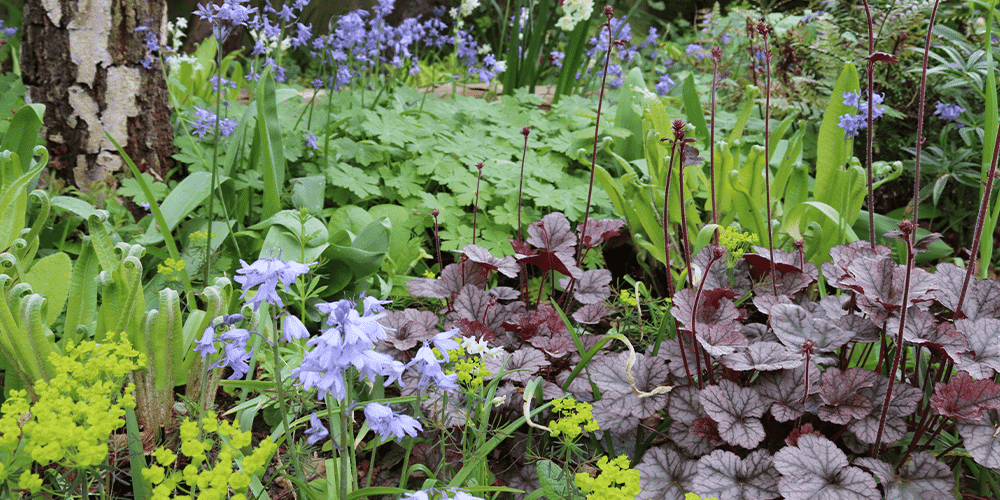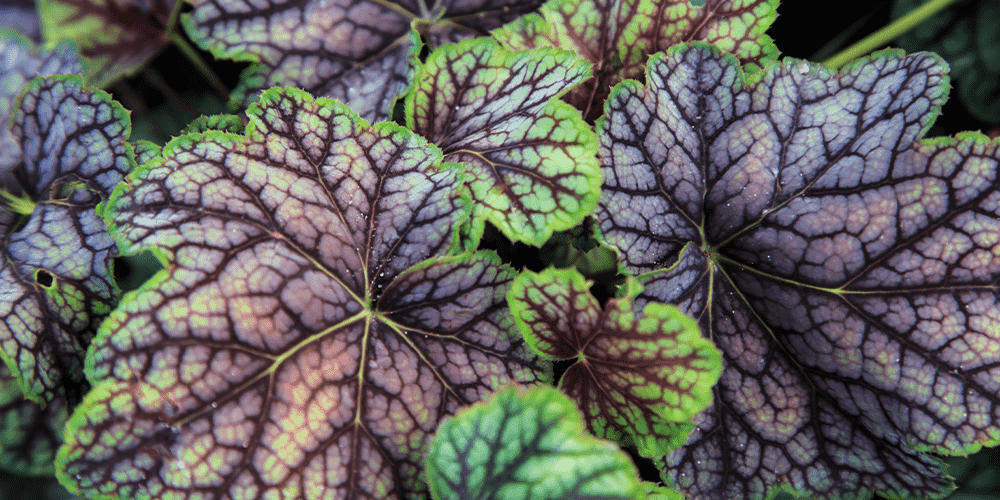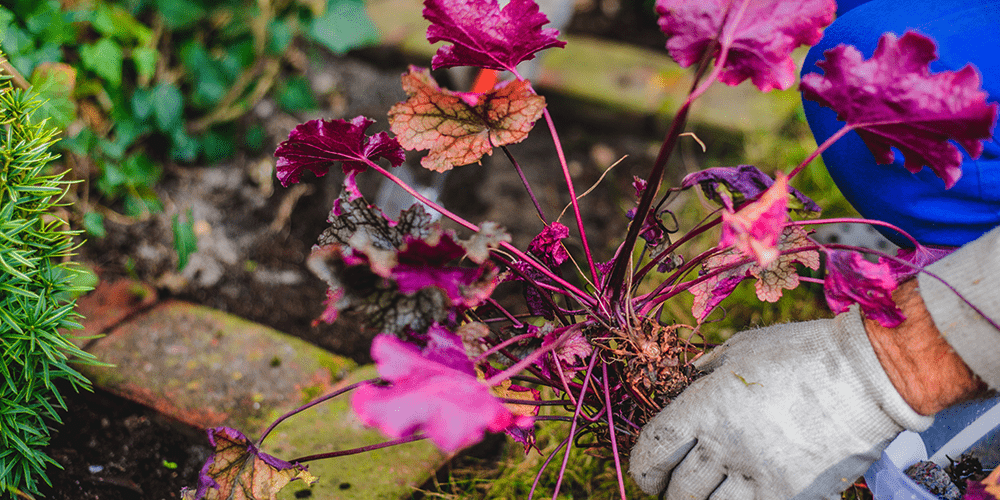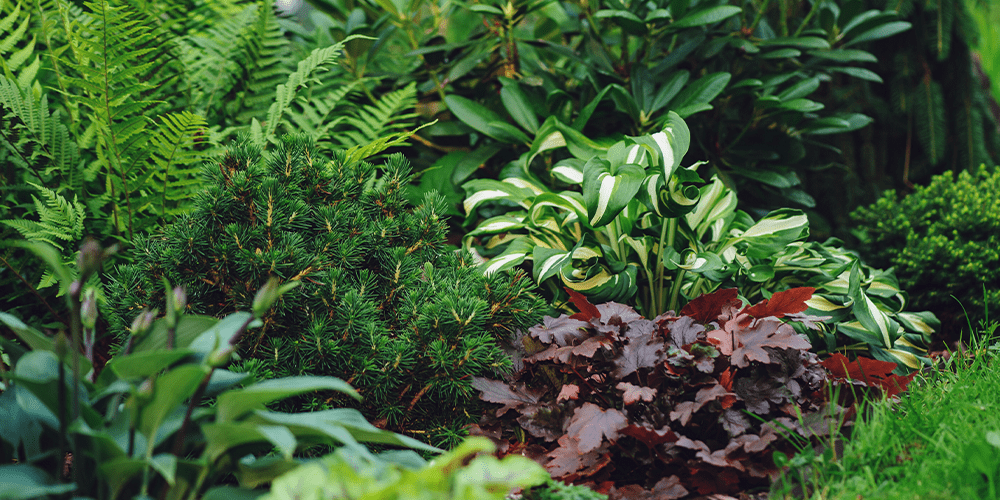Coral Bells, or Heuchera, are well-loved perennials that bring zest to the shady areas of your garden. They’re recognized by their mounded habit, long stalks of bell-shaped flowers, and amazing array of colored leaves. On top of that, they’re very hardy and easy to grow—here’s how!
The Backstory of Coral Bells
With such a colorful and unique appearance, it’s hard to believe coral bells are native to North America, but it’s true! In fact, they were one of the first plants to be brought to Europe from North America in the 1600s. In a guidebook, you’ll likely find them under their alternative name, alumroot.
Coral bells naturally have colorful leaves, but careful breeding has produced a stunning selection of varieties, including lime green, variegated green, purple, pink, and shades of pink-orange coral. The tiny flowers are usually pink or white and dangle from tall spikes above the mound of leaves.
 Sunlight for Coral Bells
Sunlight for Coral Bells
Coral bells are most at home in part-shade. They will grow in full sun; however, the color of the leaves may fade or get scorched. You can prevent scorching by giving them extra water if they are planted in full sun. It’s best to plant them in part shade, where they’re at their happiest.
How to Water Coral Bells
Ideally, coral bells will have consistently moist soil. They thrive with about an inch of water per week. Mature plants can tolerate drought, but due to their shallow roots, they can only withstand so much. During hot, dry stretches, water them every other day to keep them happy.
Soil for Coral Bells
Soil rich in organic matter is ideal for growing coral bells. Good drainage is also essential, as their crowns can easily rot when sitting in a damp, shady area. They prefer the normal range of garden soil pH, which is about 6.0-7.0.
How to Fertilize Coral Bells
Coral bells are not heavy feeders. They do well with a half-inch of compost in the spring or a light application of a slow-release, organic fertilizer. Avoid heavy fertilizing, as it can inhibit flower growth.
Seasonal Care
- Spring Maintenance: For routine maintenance, cut back last year’s leaves around the mound to let the new growth come through. The new leaves will fill in quickly.
- Summer Deadheading: The colorful leaves are the greatest appeal of coral bells. Nevertheless, the small, airy flowers are beautiful as well. They bloom from late spring to summer and continue for 2-3 weeks, sometimes repeating a second bloom cycle later in the season. To extend the bloom time, you can deadhead the spent flowers. Once the flowering has finished, cut the stalks back to promote the overall leaf growth of the plant.
 How to Propagate Coral Bells
How to Propagate Coral Bells
You can propagate coral bells by dividing the root clumps in the spring or fall. Sometimes small offsets will grow around the mother plant, which can be carefully divided and propagated to a new area. Remember to plant the new divisions quite shallow when replanting, with the soil covering the roots.
Troubleshooting Coral Bells
- Winter Heaving: The shallow root systems of coral bells sometimes make them vulnerable to lifting out of the ground during the frost-thaw cycles of late winter. If this happens, you can transplant them into a pot until the soil thaws enough to dig them back into the garden. If it’s a recurring problem, protect them over the winter with a layer of mulch around the crown.
- Common Pests: These hardy perennials are most often pest-free. However, fungal infections like powdery mildew or rust can occur. Potential insects that may attack them include weevils and foliar nematodes. The larvae of these pests can be spotted and removed by hand before they become a problem.
 Where to Plant Coral Bells?
Where to Plant Coral Bells?
Their colorful foliage makes coral bells ideal for bringing life to the semi-shaded areas of the garden. They can be planted beneath shade trees, along garden borders, or in combination with other perennials, like shade-loving hostas. The varied colors make them great partners to echo blooms of other perennials, or to bring new colors to the garden in general.
To learn more about how to grow coral bells, feel free to visit our garden center in Moultonborough, New Hampshire, and follow us on Facebook or Instagram!



 How to Propagate Coral Bells
How to Propagate Coral Bells  Where to Plant Coral Bells?
Where to Plant Coral Bells?